.jpg)
Porsche Press kit - 1998 Landing Page
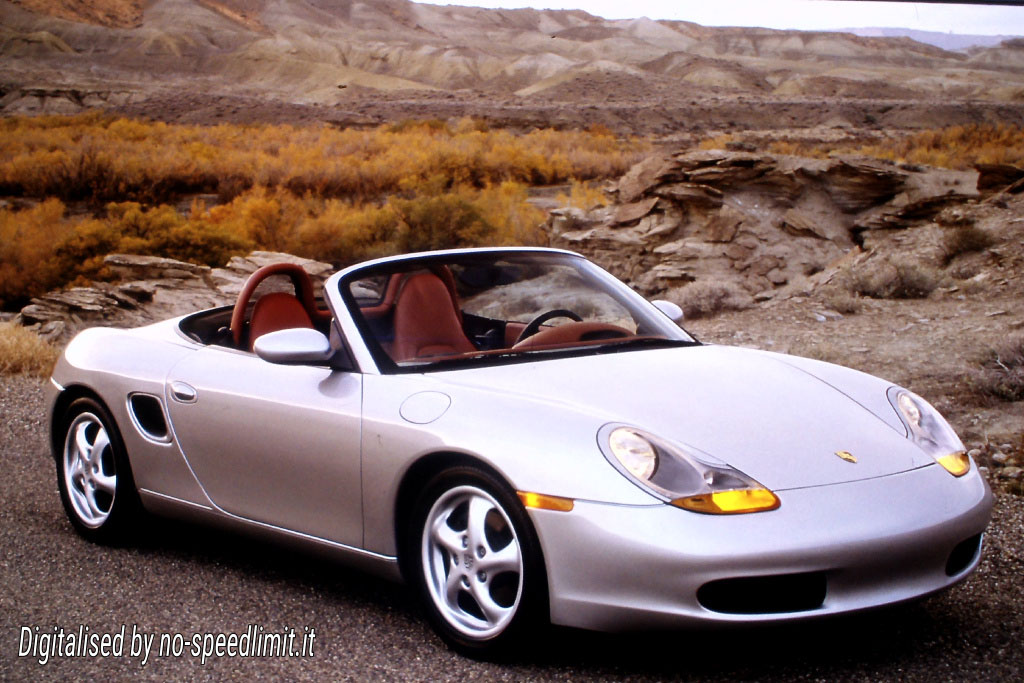
The addition of dual door-mounted side air bags is the major improvement for the 1998 Porsche Boxster, the two-seat roadster Porsche Cars North America (PCNA) introduced at last year's Greater Los Angeles and North American International (in Detroit) Auto Shows.
"The Porsche Boxster was launched to bring the Porsche sports car driving experience to a wider, younger audience," stated PCNA President and CEO Frederick J. Schwab, explaining the marketing philosophy behind the entry-level roadster. "Customer demand has shown our intentions were right on target and we underestimated the number of people in North America who value a safe, fun, high-performance vehicle that can be a weekend get-away machine as well as a daily driver."
Being intended as a daily driver means this convertible has to function in winter as well as more temperate times. Proper tires combined with the excellent traction offered by its mid-engine layout, and relatively light weight, enable the Boxster to maneuver through less-than-ideal road conditions.
The body and three layer convertible top were designed for excellent
insulation, water tightness (verified through 24-hour continuous water spray tests) and deformation resistance under heavy snow loads.
With styling and engineering cues from legendary Porsche roadsters, the Boxster-the name is a combination of "boxer" (for the engine's design) and "roadster" (for the open, two-seat layout)-was developed in three-and-a-half years following its introduction as a styling concept at the 1993 North American International Automobile Show in Detroit.
The Boxster's sports car specifications include a 201 horsepower (150 kW) 2.5-liter (151-cubic inch) engine, four-wheel independent suspension and four-wheel disc brakes with anti-lock braking system (ABS). The Boxster body and chassis are designed to crumple around a framed passenger compartment, with dual front and side air bags and supplemental safety bars among the safety features designed into every car.
The 1998 Boxster will be available with optional child seats which can automatically deactivate the passenger air bags. Created to address the concerns of child air bag safety in two-seat vehicles like the Boxster, the new Porsche child seats will both mechanically and electronically deactivate the passenger air bags when properly installed on the front passenger seat.
Installation involves the mounting of a special cross bar assembly to the front seat rail attaching bolts and reprogramming the air bag control unit by an authorized Porsche technician. Included in this assembly are a cross bar buckle and two-pin connector. After reprogramming, the passenger air bags are deactivated when the connector is plugged into the lead for the air bag control unit located under the passenger seat and the child seat belt is inserted into the cross bar buckle. When this procedure is completed, system readiness is indicated to the driver by the blinking air bag warning lamp which blinks for 10 seconds after the ignition is turned on.
The new Porsche child seat line features three different seats designed for three occupant sizes based on body weight: up to 22 lbs. (10 kg), 20 to 40 lbs. (9 to 18 kg) and 37 to 100 lbs. (17 to 45 kg). Each seat is equipped with its own safety belt system including the adapter which inserts into the cross bar buckle common to all three.
Air conditioning, power windows and mirrors, electric seat back adjustment, leather seating surfaces, AM/FM/cassette stereo system and an electrically assisted power convertible top (which opens or closes in 12 seconds) are all part of the basic Boxster package.
The first Porsche 356 prototype, designed in the late 1940's, featured open-air driving and a mid-engine configuration. The design was reprised with the 1953 introduction of the 550 Spyder, one of the most successful sports racing cars of its day. The classic styling of these earlier roadsters provides the themes for the Boxster, updated to meet the performance, comfort, convenience, environmental and safety requirements of today's market.
The Boxster's smooth aerodynamic undertray and functional front air intakes have increased downforce to help handling and stability, and the coefficient of drag has been reduced to 0.31, one of the lowest in its class. Ride stability is further enhanced by a speed-dependent rear spoiler which extends at 75 mph (120 kph) and retracts as the speed drops below 50 mph (80 kph).
Interior styling of the Boxster is a combination of retro Porsche looks with modern ergonomics. In true Porsche tradition, the ignition key switch is located to the left of the telescoping steering column. Also in Porsche style, the instruments are grouped in an arc, with three prominent gauges (speedometer, tachometer and fuel/temperature) slightly overlapping each other. Beneath the analog face gauges, there are digital displays indicating vehicle speed and oil level. An optional onboard computer displays average speed, average fuel consumption, fuel range and outside temperature. The bucket seats are leather-faced, with electric backrest adjustment. They are designed for comfort as well as side support during spirited driving.
A single button and a safety catch allow operation of the standard convertible soft top, which can be raised or lowered in 12 seconds. To reduce wind buffeting with the top down, an optional clip-on wind deflector is available. Another option is a 55 pound (25 kg) removable aluminum hardtop with heatable rear window. Styled simultaneously with the Boxster for design harmony, the hardtop is engineered to be quick and easy to install.
At the heart of the Boxster is its new engine. Although it retains the basic layout of Porsche's famed horizontally opposed, six-cylinder boxer motor, the 2.5-liter engine is new in virtually every respect. To meet future fuel consumption and emissions requirements, it is the first six-cylinder Porsche production engine to be water cooled and equipped with four-valve technology.
The 2.5-liter engine produces 201 horsepower (150 kW) and propels the car from 0-60 mph in 6.7 seconds (0-100 kph in 6.9 seconds), with a top track speed of 149 mph (240 kph), performance equal to the best in the class, as is its power-to-weight ratio. (Performance data is provided for comparison purposes only. Porsche recommends obeying all traffic laws.)
Power is transmitted to the rear wheels through either a five-speed manual gearbox or the optional five-speed Tiptronic S automatic system. The Boxster's Tiptronic S system differs from previous Porsche Tiptronic S transmissions with five forward gears instead of four and by positioning the manual mode gear selection switches exclusively on the steering wheel. Power management can be further enhanced by optional traction control (TC) and automatic brake differential (ABD) systems.
A mid-engine design provided the Porsche 550 Spyder with excellent balance and handling, and does the same for the Boxster., Suspension is independent at all four corners. The mid-engine configuration also allows for more top-down storage capacity than virtually any competitor, with luggage compartments front and rear for a total of 9.1 cubic feet (260 liters).
The Boxster's braking system features four internally vented discs with the calipers having four pistons of varying diameters (to avoid uneven brake lining wear). The braking system, housed in a race-proven monoblock casting, is backed by the latest Bosch anti-lock system (ABS 5.3).
Aluminum alloy wheels, 6J by 16 front and 7J by 16 rear, are standard equipment. They mount 205/55 ZR-16 and 225/50 ZR-16 tires, respectively. A more aggressive tire and wheel package with 7J by 17 front and 8.5J by 17 rear wheels (205/50 ZR-17 and 255/40 ZR-17 tires, respectively) is available as an option.
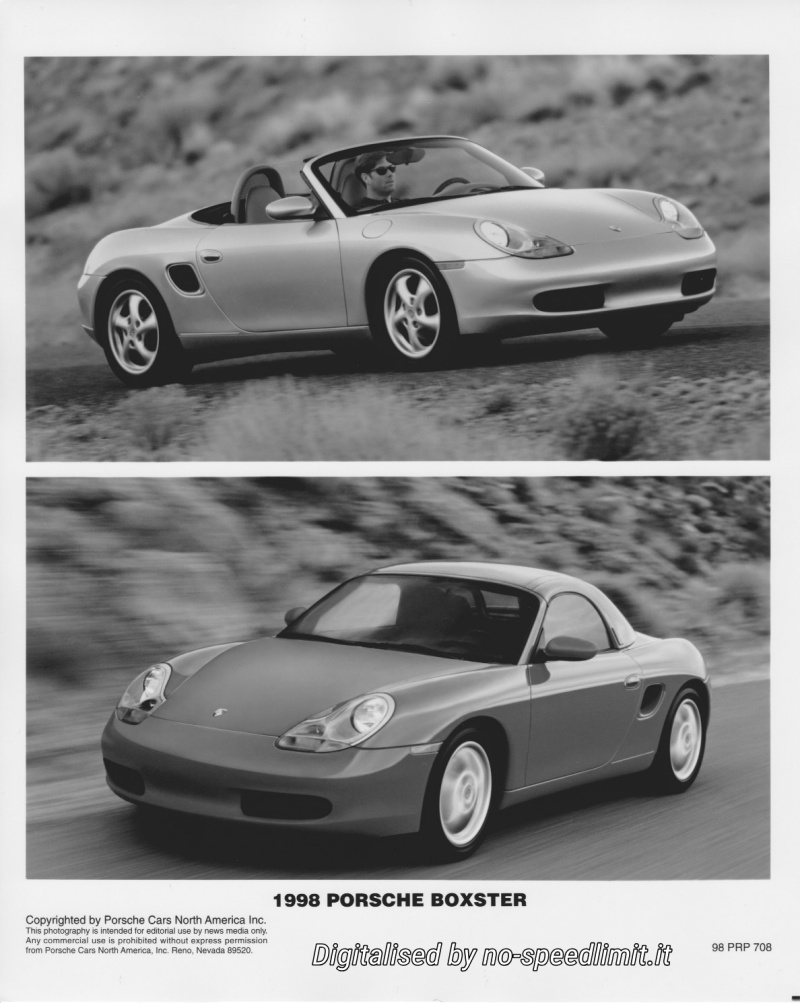
Boxster styling follows a dynamic tradition set by the original 356 and the 550 Spyder, but meets much higher levels of aerodynamic performance in terms of frontal area, total drag and total lift. Wind tunnel testing also focuses on air flow management as part of safety, driving characteristics, heating, cooling and ventilation. With a drag coefficient of 0.31 and lift forces on the front and rear axles reduced to a minimum, it sets new standards in its class.
Its smooth undertray reduces the car's drag coefficient by a full six percent, and the smooth floor pan reduces lift forces on the front axle by 36 percent. When activated, the speed dependent rear spoiler minimizes lift forces. It deploys at speeds exceeding 75 mph (120 kph), and returns to its rest position when speed drops below 50 mph (80 kph). Porsche aerodynamicists measured a lift factor of only 0.13 on the front axle and 0.10 at the rear.
To power the Boxster, an all new Porsche horizontally opposed, six-cylinder boxer engine was designed, to meet modern emissions, noise and fuel economy requirements. It utilizes water cooling and has four-valve heads for better breathing. Its displacement is 2.5 liters (151 cubic inches), and it is rated at 201 horsepower (150 kW) at 6000 rpm. Maximum torque is 181 ft. Ibs. (245 Nm) at 4500 rpm, with more than 147 ft. Ibs. (200 Nm) available between 1750 and 6500 rpm.
The engine starts with an extremely strong forged steel crankshaft running in seven main bearings. The crankshaft and auxiliary shafts driving the camshafts are housed in aluminum/cast iron bearing shells, offering consistent bearing play regardless of temperatures, and reducing mechanical noise, Forged steel connecting rods are broken mechanically at the bottom end along a dividing line marked by a laser beam. When the rods are fitted onto the bearings, the crystalline fracture surfaces provide an ideal mating surface. The cracking technique is featured for the first time with the forged connecting rods in the Boxster engine.
The alloy engine block, separated down the center, has the three cylinders on each side arranged in an open deck design within the block. The flow of coolant around the cylinders and combustion chambers follows crossflow cooling principles applied by Porsche in the design and construction of racing engines. Coolant flows along the entire width of the cylinder bank and cylinder heads from the intake to the exhaust side. Flow in the new boxer engine extends up and down in two directions on either side, thus ensuring thermal stability. One coolant flow extends around the cylinders inside, a second around the combustion chambers on the outside.
Porsche has used a new Lokasil casting technology for the engine block. Cylinder liners are made of an abrasion-resistant alloy made by adding silicon. Before casting, the cylinder liners are fixed in position, then surrounded by a conventional aluminum alloy casting. The Lokasil process applies the required silicon only where it is needed, hence the name: Localized Silicon or Lokasil.
A new lubrication system design, known as integrated dry sump lubrication, means the lubricating oil sump forms part of the engine block on the new boxer engine, although it is separated from the crankshaft chamber. The advantage, versus the 911 engine design with its separate oil tank, is simplification. The number of hoses and tubes is reduced to a minimum. On the pressure side, a geared oil pump at the front end of the engine ensures the supply of oil, which then returns to the reservoir from the crankshaft bearings. Oil in the cylinder heads is pumped back by two return pumps. The oil pickup is housed in a reservoir beneath a partition that prevents the oil from flowing to the sides under lateral acceleration by means of baffle plates, keeping oil in the pickup under all driving conditions.
Temperature balance is provided by an oil/water heat exchanger mounted to the engine block. During warm-up, this system warms the oil directly from the heat of the engine coolant, so the engine reaches its operating temperature quickly. Whenever oil temperature exceeds the coolant temperature, approximately 200° F (90° C) under high load, the heat exchanger process is reversed with the oil dissipating heat to the coolant. The engine oil level is displayed each time the engine is started by a gauge in the instrument cluster. A service unit in the rear luggage compartment houses an oil dipstick and the fillers for engine oil and coolant.
The latest Bosch Motronic M 5.2 electronic engine management system controls both electronic fuel injection and electronic ignition systems on the Boxster engine. Fuel supply is sequential, through one injector per cylinder, following the engine's firing order. The amount of fuel injected is determined by a hot film air mass metering system located in the intake manifold and by the dual exhaust system oxygen sensors.
The Bosch ignition system is all-electronic, featuring solid state ígnition distribution via six individual coils, with no mechanical distributor. The system features cylinder selective anti-knock control that retards the ignition timing of individual cylinders which are about to knock. The Boxster's Motronic engine management system includes a second generation on-board diagnostics system (OBD II) for the North American market.
With four valves per cylinder, the spark plugs are centered in the combustion chambers for consistent ignition and combustion of the fuel/air mixture. Dual ignition, with two spark plugs per cylinder as in Porsche's air-cooled boxer engines, is not required. The cylinder heads are identical and can be fitted to either the left or right cylinder bank with no modifications.
Lightweight reinforced plastic with smooth surfaces for increased air flow in the intake tract is used in the construction of the intake manifold. Intake air supply is controlled by a central throttle butterfly, while fuel is injected sequentially through six electronic fuel injectors. Exhaust gases pass through two stainless steel exhaust manifolds and exit through two catalytic converters into the muffler and a single central tailpipe reminiscent of earlier roadsters.
The engine is accessible from underneath, from above and from the front through service openings. Electronic engine management is maintenance-free but can be checked by computer via the on-board diagnostic system. Camshaft timing chains as well as the poly-V belts driving the alternator, water pump, hydraulic pump and air conditioning compressor all feature automatic tensioning.
Cooling studies show the only way to provide heat dissipation under worst-case conditions is to mount the radiator at the front end of the car. Due to the required front luggage space, the radiator could not be placed in the normal position. Porsche's engineers decided on a unique split the radiator in half, and placed the two halves in the fenders, in front of the wheels, to generate a flow of cooling air under all conditions. ution: they
Air flow coming out of the body upstream of the front wheels provides two advantages. Aerodynamic drag does not suffer from the fact air flows through the radiators, and the upward flow of air coming out of the radiators counters lift forces on the front axle. The air scoop on the left side of the car supplies intake air to the engine through an air filter, while hot air from the engine compartment is forced out by a fan located inside the right side air scoop.
In the Boxster engine, the intake and exhaust valves are driven by four overhead camshafts and bucket tappets with hydraulic valve lash compensation. Intake camshaft opening times are controlled by Porsche's patented VarioCamTM system. With an automatic chain tensioner and hydraulic valve lash compensation, the entire valvetrain system is maintenance-free.
First used on the Porsche 968 four-cylinder 3.0-liter (183-cubic inch) engine, VarioCamTM alters camshaft timing for greater engine torque. VarioCamTM uses a timing piston, controlled by the Bosch Motronic M 5.2 engine management system, placed between the two sides of the timing chain between the intake and exhaust cams.
When actuated, the piston advances the timing of the intake cam by 15 crankshaft degrees or 7.5 camshaft degrees.This earlier valve timing creates more valve overlap and an earlier closing time than normal, resulting in additional engine torque. At high engine speeds, the piston is shifted back to its later timing position for more power. The effect of the VarioCamTM system is to give the Boxster engine a broader, flatter torque curve. VarioCamTM also lowers exhaust emissions. Late intake cam timing results in shorter valve overlap periods and reduced hydrocarbon emissions at low speeds and at idle. Early valve timing and long valve overlap times create exhaust gas recirculation at low loads and moderate engine speeds, reducing NOx emissions. VarioCamTM valve timing also improves cold-start emissions.
The Boxster engine includes a compact system for driving the four overhead camshafts: the first drive element is a chain leading from the crankshaft to the intermediate shaft. From there, at the front end of the engine, a second chain drives the right side exhaust camshaft, with a third chain running from the clutch side to the left side exhaust camshaft.
This three-chain system allows the chains to use the space provided by the two offset cylinder rows of the boxer engine. Two small chains connect the exhaust and intake camshafts. The valves, closed by conical springs, are operated by hydraulic tappets with automatic lash compensation. The camshaft drive chains maintain correct tension for the life of the engine.
Emissions System The Boxster engine features a monitoring system for all components with exhaust emission control relevance. Any time the car is driven, the OBD II (on-board diagnostics, second generation) system measures the efficiency of the catalytic converter, identifies misfiring, and monitors the fuel system, fuel tank venting, secondary-air injection, oxygen sensors and other components and systems which affect exhaust emissions.
The Boxster comes with transmissions tailored to the power and performance characteristics of the 2.5-liter (151-cubic inch) boxer engine. It comes standard with a five-speed manual gearbox featuring gear ratios designed for optimum performance. The short transmission ratios allow acceleration performance of 0-60 mph in 6.7 seconds (0-100 kph in 6.9 seconds) and flexibility, with 50-75 mph (80-120 kph) acceleration in fifth gear in 11.4 seconds.
The Boxster is also offered with an optional Tiptronic S five-speed automatic transmission. Like the existing four-speed Tiptronic S on the 911, an electronic system shifts gears and controls the mechanical lockup clutch in the torque converter. The transmission control unit features five different adaptive shift programs, applied according to the needs of the driver, with a range extending from economy to performance.
The Tiptronic S electronic transmission makes logical decisions in choosing the right gear. Whenever the driver suddenly takes his or her foot off the accelerator, the system will sense the car is no longer under power and will prevent the transmission from shifting up, keeping the current gear engaged. Applying the brakes will make the transmission shift down at the appropriate road speed. Grade detection prevents the transmission from upshifting too soon on uphill and downhill grades. Whenever the wheels spin on slippery roads, the automatic transmission will upshift earlier for torque management and driving stability.
The driver participates in the shifting process, choosing either the manual or automatic shift mode. The choice of manual or automatic mode depends on the position of the selector lever. Once selection of the manual mode is made, shifting is done exclusively through the upshift and downshift buttons on the steering wheel.
The optional traction control (TC)) system provides traction when accelerating on slippery surfaces, It operates throughout the entire speed range, combining Porsche's optional automatic brake differential (ABD) and electronic intervention in the engine management system to reduce power as soon as the driving wheels start to spin.
The wheel spinning faster is slowed down by the wheel brake. If both drive wheels spin despite ABD, the wheels are slowed down to maintain traction. Brake intervention is combined with the engine management system, which cuts fuel injection when necessary, then retards the ignition timing in order to reduce engine torque. Traction control can be deactivated by a console switch, while the automatic brake differential remains active. With traction control turned off, under acceleration the car will react like a vehicle with a conventional limited slip differential.
The Boxster's mid-engine design concentrates the weight in the middle, which serves to reduce the inertia moment around the car's vertical axis. What this means in practice is very agile response to steering inputs with smooth and nimble behavior in curves. With the Porsche Boxster's equal axle load distribution, its low center of gravity and its relatively long wheelbase, the car offers excellent driving characteristics.
Rack-and-pinion steering features hydraulic power assist. Bumps or adverse forces coming up from the road are absorbed by the hydraulic steering mechanism, and power assist substantially reduces the steering forces required when maneuvering and parking. The telescoping steering column adapts to the driver's needs and provides the precision required by demanding drivers.
Front and rear suspension systems on the Boxster are versions of the MacPherson strut design, with transverse control arms and spring struts. On the front axle, the subframe, transverse control arms, longitudinal arms and wheel supports enclosing the shock absorbers are all made of cast aluminum. At the rear, the aluminum transverse control arms, longitudinal arms, wheel supports as well as the shock absorbers are connected to an aluminum assembly that reinforces the rear body structure.
Suspension performance inspired by the Porsche 911 Carrera was specified for the Boxster to ensure directional stability, lateral acceleration and controllability under all conditions, with smooth and forgiving behavior at the limit. The "Weissach" axle, a design offering increased safety under extreme driving conditions, was developed by Porsche for the 928, a modification of axle geometry under lateral forces in bends called elastokinematics. On the 928, this effect generated toe-in on the rear axle alone through kinematic forces, thus countering oversteer.
The Boxster takes this design a step further. The Boxster's elastokinematic suspension design provides a negative toe position on the outer front wheel under the influence of lateral forces. The outer rear wheel then develops a positive toe position. With increasing lateral acceleration, this system minimizes the normal consequences of weight transfer.
Large wheels and tires contribute to the Boxster's dynamic performance on the road, with 6J by 16 alloy wheels in front and 7J by 16 alloy wheels at the rear. Tire dimensions are 205/55 ZR-16 at the front and 225/50 ZR-16 on the rear wheels. Available as an option are larger wheels, measuring 7J by 17 at the front and 8.5J by 17 at the rear with 205/50 ZR-17 front and 255/40 ZR-17 rear tires.
All-disc power brakes on the Boxster feature alloy four-piston brake calipers in a single-piece, or monoblock, design. The single-piece brake caliper design comes straight from the Porsche 911 GT1 race car, and is of the same type used in Formula One. Brake discs are internally ventilated front and rear, and the anti-lock braking system (ABS 5.3) is fitted as standard.
The calipers each have four pistons which vary in diameter to avoid uneven brake lining wear. In addition to the heat dissipation reserves of the Boxster's brakes, cooling air flows to the front discs, not just through two ducts, but also through two guide spoilers connected to the longitudinal control arms. They ensure that brake cooling air is always plentiful. The alloy monoblock brake design minimizes brake fade even under extreme conditions.
The new Boxster is a long-distance touring roadster with ample cockpit space for two persons and two trunks with a total capacity of 9.1 cubic feet (260 liters) for luggage. Porsche designers could have chosen lightweight body materials like aluminum or fiberglass. Instead, the entire body shell of the Boxster is made of two-sided hot galvanized steel, because steel offers better deformation performance and ease of repair.
The Boxster's patented front end structure improves body integrity without extra weight by using reinforced high-strength body panels. The side impact panels in the doors, as well as the reinforcements on the bulkhead crossmember, are made of steel/boron alloy formed at high temperatures. Where strength or design features can only be achieved by stamped parts, Porsche has used tailored blanks, laser-welded metal blanks of varying thicknesses, to provide extra strength.
Porsche engineers saved weight by leaving out material wherever possible on stampings, which are corrugated to provide overlap of welded body panels. The supplemental safety bars behind the cockpit are made of stainless steel. Steel reinforcements are built into the windshield frame for added stre in the event of a rollover. With these technologies, the Boxster's roof strength meets North American safety standards for coupes.
Nearly 20 percent of the parts and components on the Boxster are made of aluminum, resulting in an overall vehicle weight of 2822 pounds (1280 kg). In addition to the complete engine and the transmission housings, the suspension components, transverse arms, wheel rims and brake calipers are all made of aluminum.
The mid-engine design offers safety in an accident, enhanced by a series of deformation structures that absorb energy placed between the outer contour of the car and the passenger cell. Impact forces are reduced, and the crumple behavior of the steel body minimizes collision forces acting on the driver and passenger. Safety is further enhanced by two full-size front air bags fitted as standard equipment in all markets, one mounted in the steering wheel hub and the other in the instrument panel. The 1998 Boxster will also have as standard equipment two door-mounted side air bags as part of the 1998 Porsche Side Impact Protectection System. The two 30-liter air bags provide improved protection for head, chest, pelvis and arms in a side impact.
Aero headlamp units in the Boxster's nose offer unusual design and a high level of function and optical quality. The surface covers are made of a high-strength plastic resistant to most types of damage usually encountered on the road, and are lighter than conventional glass headlamp covers. The low beam and high beam are projected by separate headlamp systems to provide high quality illumination for night driving. Both beams have free-form reflectors using the entire cross section of the headlamp for greater illumination intensity. The beams intersect as they leave the reflectors to produce high light yield from a compact design. The fog lamps use small reflectors.
The Boxster's cockpit offers a new rendition of classic Porsche style, with the ignition lock located to the left of the steering wheel as is traditional. Instruments are grouped in an arc with three large gauges slightly overlapping each other. The most prominent feature is the central tachometer, with the analog speedometer to the left. For the first time, the numbers on the analog scales use the same type face as the model designation at the rear of the car.
Analog displays for road speed, engine speed, coolant temperature and fuel level on the Boxster dashboard are augmented by three additional digital displays: the odometer, the trip odometer and a digital speedometer beneath the tachometer, displaying in either English or metric units. An oil level display allows the driver to check the engine oil level each time the ignition is turned on. An optional onboard computer displaying average speed, average fuel consumption, fuel tank range and outside temperature, with an acoustic warning which sounds whenever the car exceeds a preset speed limit, is also offered.
Boxster's twin bucket seats meet Porsche standards for side support and comfort. Fore-and-aft adjustment is controlled by a spring and backrest adjustment is electric. The driver's seat comes with manual height adjustment.
Thermoplastic polyolefin (TPO) film, a special polypropylene material, is used for the large interior trim pieces in the Boxster. This material does not cause a chemical odor inside the car nor does it produce a layer of mist on the windows. With the same type of plastic being used for the base components, trim and controls, future recycling of Boxster interior components will be easy and convenient.
Climate control system controls are integrated into the instrument panel module, and the heating system operates consistently, regardless of engine load and temperature. With the heater controlled as a function of air flow, heat is available quickly from the heat exchanger, with its constant supply of hot coolant. Air conditioning is standard. The climate control system comes with an air recirculation switch to keep out dust or unpieasant odors.
To reduce air buffeting inside the car and to allow for quiet conversations, Porsche offers a multi-piece wind deflector consisting of two perforated panels, clipped in position on the supplemental safety bars behind the seats, with a plastic window in between to provide clear vision through the interior rearview mirror.
The power convertible top of the Boxster provides maximum comfort and convenience for the occupants, with excellent weather sealing and efficient noise control for driving at high speeds. Extensive work in the Porsche wind tunnel reduced wind noise to a minimum.
A new type of kinematic structure folds the top like the letter "Z" before it disappears beneath the top cover. The top spars are made of cast magnesium. They move smoothly and easily, opening and closing via a compact electric motor. Once the driver releases a central latch on the windshield frame, opening or closing the top takes only 12 seconds.
An aluminum hardtop is available as an option to further reduce the noise level inside the car and to maintain a consistent interior climate. The removable hardtop, with heated glass window, weighs 55 pounds (25 kg).
Every new Porsche Boxster is covered by a two-year bumper-to-bumper limited warranty with unlimited mileage, which includes Porsche's roadside assistance program. The galvanized body and 26-step paint and anti-corrosion process enable Porsche to warrant each car against rust perforation for 10 years and unlimited mileage. In addition, the paint has a three-year limited warranty.
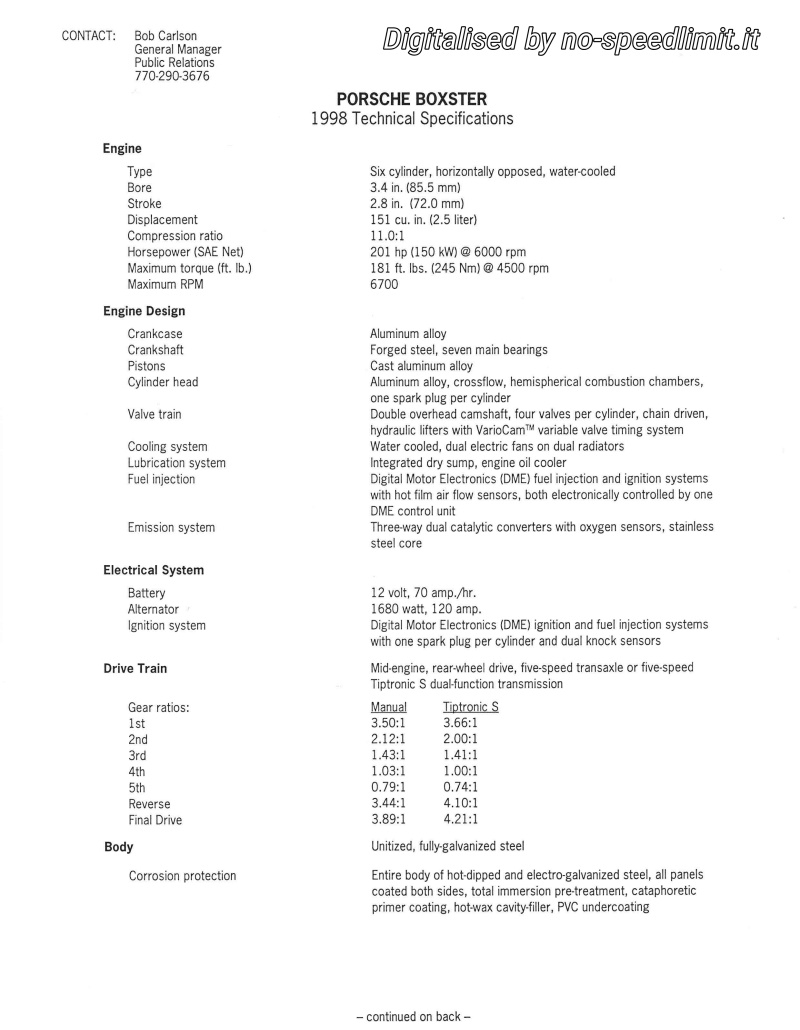

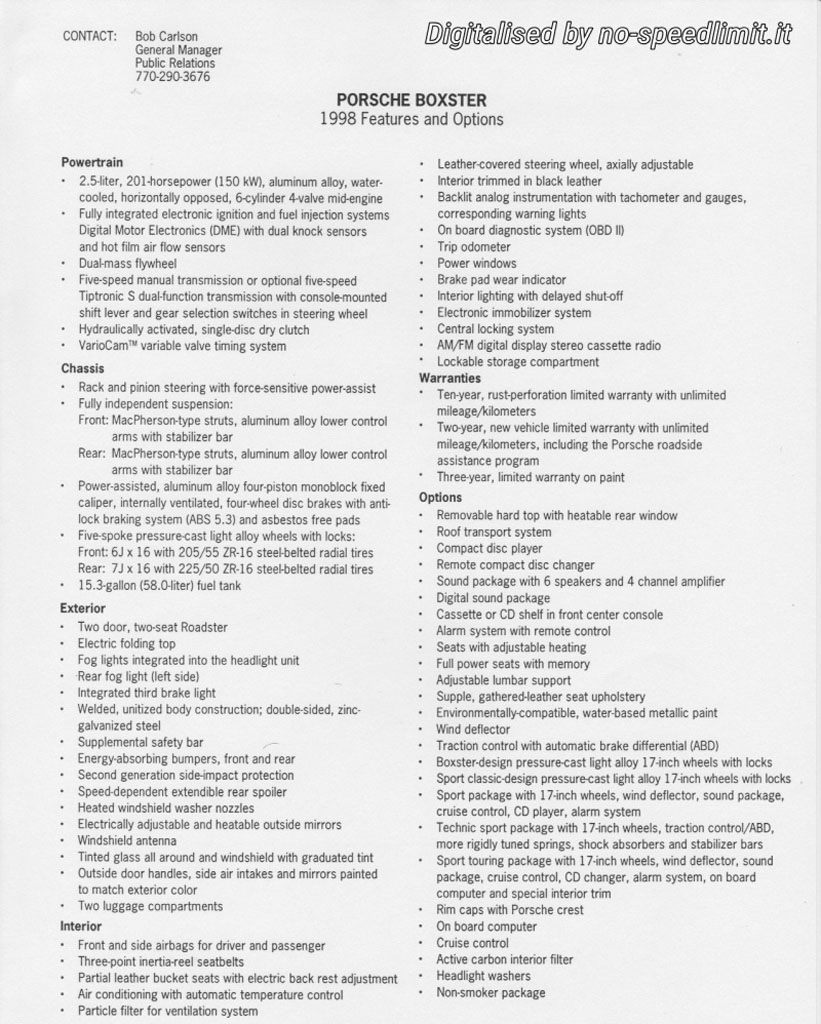
.jpg)
Porsche Press kit - 1998 Landing Page
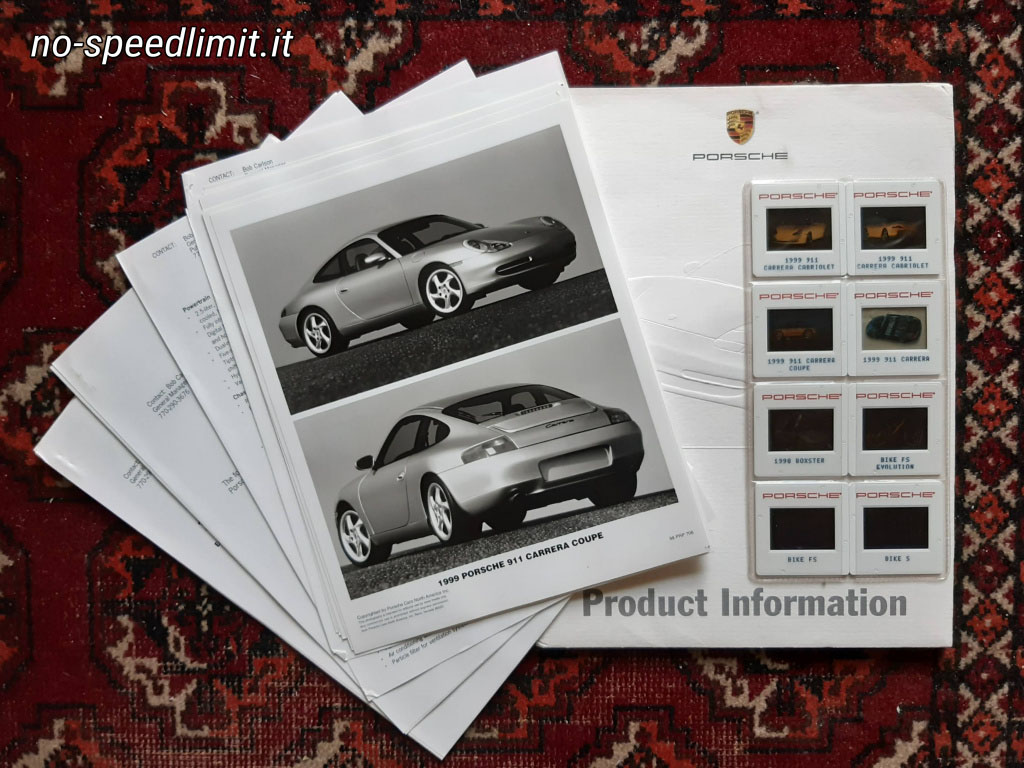
Porsche Press kit - USA production models (1998/99)

Porsche Press kit - RoW - Boxster (1999 MY)

Porsche Press kit

Porsche Literature

Our Porsche Cars